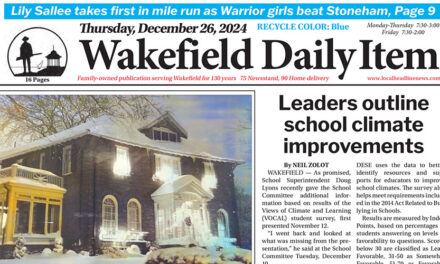By NEIL ZOLOT
WAKEFIELD — As promised, School Superintendent Doug Lyons recently gave the School Committee additional information based on results of the Views of Climate and Learning (VOCAL) student survey, first presented November 12.
“I went back and looked at what was missing from the presentation,” he said at the School Committee Tuesday, December 10.
School Committee member Melissa Quinn was interested in how Wakefield compared to other communities, so Lyons provided a comparison to the town’s state Comprehensive Assessment System (MCAS) test District Analysis and Review Tool (DART) cohort of 11 communities and 11 of 12 Middlesex League Communities, because Woburn did not provide data.
VOCAL is a survey from the state Department of Elementary and Secondary Education (DESE) of students in grades 4, 5, 6, 8 and 10 given around the time they take MCAS. It is based on directives from the federal Department of Education and DESE uses the data to better identify resources and supports for educators to improve school climates. The survey also helps meet requirements included in the 2014 Act Related to Bullying in Schools.
Results are measured by Index Points, based on percentages of students answering on levels of favorability to questions. Scores below 30 are classified as Least Favorable, 31-50 as Somewhat Favorable, 51-70 as Favorable and over 70 as Most Favorable. Ninety three percent of Wakefield students in the designated grades participated, higher than the state average of 73 percent.
Overall, Wakefield scored 53 on the general School Climate and 52 each on Engagement (the extent students feel adults value diversity, feel there is a social connection and respect between staff and students and among students and feel engaged intellectually and emotionally), Safety (the extent students feel safe and bullying is dealt with effectively) and Environment (the extent students feel they are in a positive instructional environment and feel they have academic support).
The state-average score in those categories are 50 in School Climate, Engagement and Safety and 51 in Environment.
In the DART cohort, Wakefield ranked 4th in Social Climate and Safety and 5th in Engagement and Environment. The closest communities in the cohort are North Andover and Wilmington. North Andover scored 44 in Social Climate, 46 in Engagement, 42 in Safety and 45 in Environment. Wilmington scored 52 in Social Climate, 52 in Engagement, 50 in Safety and 53 in Environment. “We’re kind of in the middle of the pack,” Lyons feels.
Wakefield students placed lower in the DART cohort in MCAS results. For grades 3-8 Math Wakefield was 10th, for grades 5 and 8 Science it was 8th, for grade 10 ELA it was 11th and for grade 10 Math it was 10th.
In the Middlesex League VOCAL comparison, Wakefield ranked 4th in Safety, 6th in Social Climate and 7th in Engagement and Environment.
Wilmington is also in the Middlesex League as are two communities that border Wakefield, Melrose and Reading. (Often the best benchmark for one community and school system to compare itself to another is to just use the school its football team plays on Thanksgiving, in this case Melrose.)
Melrose scored 46 in Social Climate, 47 in Engagement, 45 in Safety and 47 in Environment. Reading scored 48 in Social Climate, 53 in Engagement, 41 in Safety and 54 in Environment.
Lyons highlighted results at Wakefield Memorial High School. Ninety four percent of students felt engaged and welcome to participate in extracurricular activities and clubs, but only 80 percent of low income students did, perhaps because of costs associated with such activities or having jobs. Only 78 percent of high school students participated in the survey, higher than the all-age state average of 73 percent, but lower than the all age town average of 93 percent led by 100 percent at the Walton Elementary School and 99 percent at the Galvin Middle School.
Eighty seven percent of high school students responded positively to the statement “teachers support me even when my work is not my best,” but 42 percent of student responses answered the level of pressure they feel to perform well is unhealthy.
Eighty seven percent of Wakefield Memorial High School students also responded they feel safe and have a sense of belonging, but only 79 percent of Hispanic/Latino students and 72 percent of low income students did, with some falling into both subgroups.
Results at middle and elementary school levels are generally more positive as students generally feel more positive about school.
Lyons also outlined two goals related to the results, the first being to “foster a school environment where all students feel valued, respected and connected,” and the second being to “ensure all students continue to feel physically and emotionally safe while improving the learning environment.”
Action steps include implementing and expanding peer leadership programs to support students to build relationships and contribute to an improved school environment; providing professional development for the staff on belonging and equitable education; expanding programs promoting peer empathy and respect; reviewing and updating school safety protocols including anti-bullying initiatives and emergency preparedness; tracking bullying and student discipline data to establish a baseline and work to reduce incidents of bullying and conflict, and training staff in conflict resolution to support students’ emotional needs.
“We want to know not just what we’re doing well, but what we need to do better,” School Committee member Peter Davis said of the areas for growth Lyons outlined.
“This is something we can look into,” Chairman Stephen Ingalls feels. “I appreciate the additional information. We know students do their best work when they feel supported.”





